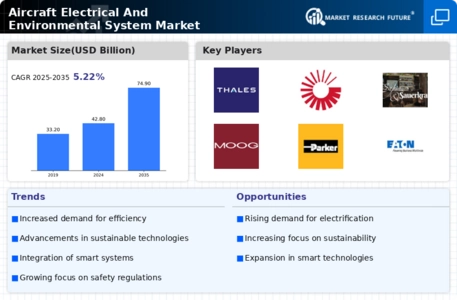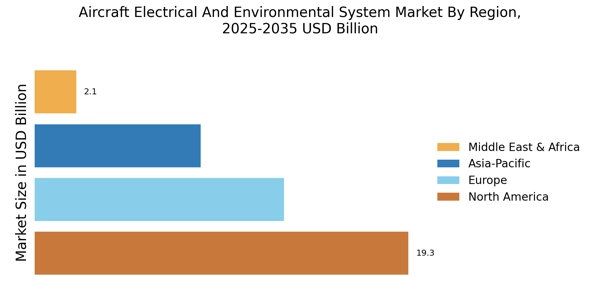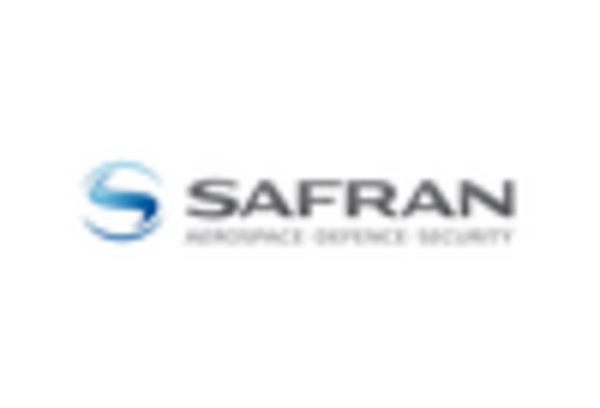Growth in Air Travel
The Aircraft Electrical And Environmental System Market is benefiting from the consistent growth in air travel. As more individuals and businesses opt for air transportation, airlines are compelled to expand their fleets and enhance existing aircraft. This expansion necessitates the incorporation of advanced electrical and environmental systems to ensure passenger comfort and operational efficiency. Recent statistics indicate that air travel demand is projected to increase by approximately 4.5% annually over the next decade. This surge in demand is likely to drive investments in the Aircraft Electrical And Environmental System Market, as manufacturers strive to provide cutting-edge solutions that meet the evolving needs of airlines and passengers alike.
Increased Demand for Fuel Efficiency
The Aircraft Electrical And Environmental System Market is experiencing heightened demand for fuel-efficient aircraft. Airlines are increasingly focusing on reducing operational costs, and advanced electrical systems play a crucial role in achieving this goal. The integration of lightweight materials and energy-efficient technologies in aircraft design has led to a significant reduction in fuel consumption. According to recent data, aircraft equipped with modern electrical systems can achieve fuel savings of up to 20% compared to older models. This trend is likely to continue as airlines seek to enhance their competitive edge while adhering to environmental regulations. Consequently, the Aircraft Electrical And Environmental System Market is poised for growth as manufacturers innovate to meet these demands.
Focus on Passenger Comfort and Experience
The Aircraft Electrical And Environmental System Market is increasingly focused on enhancing passenger comfort and experience. Airlines recognize that providing a superior travel experience is essential for customer satisfaction and loyalty. This has led to the adoption of advanced environmental control systems that regulate cabin temperature, humidity, and air quality. Additionally, innovations in lighting and entertainment systems are being integrated to create a more enjoyable atmosphere for passengers. Recent surveys indicate that passengers prioritize comfort features, which has prompted airlines to invest in modern electrical systems that cater to these preferences. As a result, the Aircraft Electrical And Environmental System Market is likely to see sustained growth as airlines strive to improve the overall passenger experience.
Regulatory Pressures for Emission Reductions
The Aircraft Electrical And Environmental System Market is significantly influenced by regulatory pressures aimed at reducing emissions. Governments and international organizations are implementing stringent regulations to curb greenhouse gas emissions from aviation. This has prompted aircraft manufacturers to invest in more efficient electrical and environmental systems that comply with these regulations. For example, the International Civil Aviation Organization has set ambitious targets for reducing aviation emissions, which has led to increased demand for innovative technologies. Consequently, the Aircraft Electrical And Environmental System Market is expected to grow as manufacturers develop solutions that not only meet regulatory requirements but also enhance the overall sustainability of air travel.
Technological Innovations in Aircraft Systems
The Aircraft Electrical And Environmental System Market is witnessing a wave of technological innovations that are transforming aircraft design and functionality. Advancements in avionics, power management systems, and environmental control systems are enhancing the overall performance of aircraft. For instance, the introduction of fly-by-wire technology and advanced energy management systems has improved aircraft safety and efficiency. Furthermore, the integration of smart technologies, such as predictive maintenance and real-time monitoring, is becoming increasingly prevalent. These innovations not only improve operational efficiency but also contribute to the sustainability goals of the aviation sector. As a result, the Aircraft Electrical And Environmental System Market is likely to see continued investment in research and development to foster these advancements.


















Leave a Comment